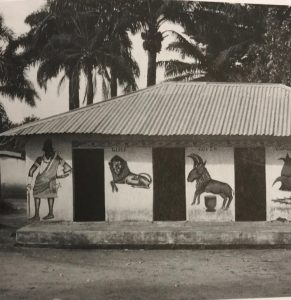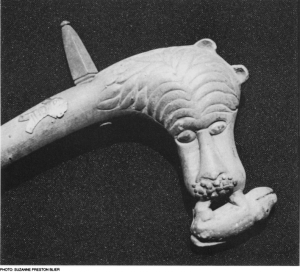Seth Epling

The object was stuck in a falling state, suspended in mid air. A weapon among an altars, a scepter surrounded by crowns. I wanted to know why there was such a violent looking object in a place where everything else is full of color and life. The scepter does not stand out. It has little color and small designs that are worn away. The handle is a simple, wooden staff. The kind of wood that if you held it, it would give you splinters. There are three brass segments on staff. Above the one at the top, there is a catlike creature. It is a very interesting creature with a big cat body and long ears or horns. The shadow this creature cast upon the wall intrigued me and prompted me to chose this object. Right before the axe head, two horns protrude out of the wood. There is the blade that is made of metal with a tidal wave design throughout the edge. There are two metal pieces that hold down the blade, an S shaped piece and a spring piece. The last thing on the scepter is a flower with 6 petals right below the horns. On every other petal there are bumps that seem to make a simple pattern. Why is this deadly object in a place of surrounded by objects of worship? This question even relates to the scepter itself. The flower on the staff begs the same question. I wanted to learn everything about this scepter and the god it represented, Hevioso. Contrary to its looks, it is not a weapon, it a tool used for religious and political festivals. Why use a violent looking object to demonstrate religious and political power. The answer lies in the god Hevioso. As a hot god, Hevioso does things quickly and people who have him as a deity are usually in power. This leads me to argue that this scepter was used to show power over the king’
s followers. In the rest of the paper, I will first explain how ase (às̩e̩ or ashe) plays an important part in understanding this object. Then I will explain the cat creature on top of the staff and the significance it has towards the scepter. I will then give background on the implications of ase, Hevioso and how King Glele praises Hevioso and basic information on vodou and Yoruba tradition. Next, I will talk about a king who was represented by the same god, Hevioso, King Glele and will then show how the scepter would be used in a festival based on first hand basis of people who research the religion.
For any object in the religion of vodou to have any significance, it needs to have ase. Ase is a word that most closely means it has power and meaning. According to Professor Abiodun, a Black Studies professor at Amherst college, for any object to have ase, it needs be be activated and be in context. An object has to be active in order for the real meaning to be found. Activation means that there is a deity that is apart of the object. This deity gives the object power and context. I use context because art and parts of festivals can not be taken out. There are no art exhibits in the yoruba and haitian land because those people are living in parallel with their art. What we would put on display they use in their everyday life and it has way more meaning with them using it. This is one reason why looking at this scepter as it is hard to understand. It is being taken out of the ritual which it was crucial in.
Ase would be present in the scepter as a whole but many of the small parts also would have contained ase. One of the smaller parts that would have had lots of ase was the creature. The cat creature on the scepter is a symbol for both the king and Hevioso. In the picture of the Nesuhwe shrine house in Abomey from the book Asen, Ancestors, and Vodun there are two animals. There is a lion with a name above that say “Glele” and on the right side, there is an animal for “Ghezo”. Ghezo is the predecessor to Glele and his father. King Glele will be discussed later in much more depth. This animal is thought to be a buffalo because one part of his symbol is a buffalo, according to the new world encyclopedia. These two animals have something in common. They both have incredible brute strength, are insanely fast, and are fear in the animal kingdom and by humans. This is important later when I discuss Hevioso.

Photo by E. Bay
In what is now the country of Benin, there was a kingdom named the Dahomey kingdom which ruled for around 300 years from 1600s-1900s. This kingdom was ruled by many kings who passed along their status to their children. The main religion was Vodou, a religion based of the following of spirits. Some of these spirits are ancestral, but every person has a deity that guides their journey. This is very similar to the religion of Yoruba, many of the gods between these two religions have the same duties but have different names. Yoruba is a major religion in West Africa, including Nigeria, Benin, and Togo. Yoruba was the precursor to many other religions, including vodou, that now span the world. This fits in the category of diaspora religions, or religions that were spread because the atlantic slave trade.
Every king had their own scepter to show power and royalty. Each scepter also was a symbol for the god that the king represented. One god that many kings represented was Hevioso, the god of thunder for Vodou, whom is similar to Shogun, the god of thunder for Yoruba religion. “Hevioso is associated with the lightning-like gunfire and cannon during battle… Hevioso played an important role in war.” (Blier, 51)..Hevioso is a god that likes to accomplish things quickly and effectively which is why many kings felt empowered by him. Hevioso is considered to be a hot god or petwo which is misconceived as an angry god. This is a misconception because Hevioso was helpful to the king and did what the king requested but his style of actions was perceived as angry. Often, Hevioso is represented as a lion or an animal that is both mentally and physically strong because of his pride and his intensity. Hevioso by The 69 Eyes. This is a song where Hevioso is praised. In the song, the beat is made to sound like thunder, there is a lot of bass which emulates the feeling of when thunder rumbles throughout the land. Looking back at the two animals that represented two kings, the lion and buffalo, it is easy to see how they relate to Hevioso. They are both fierce and strong. They both do things that the believe are right for themselves and who they take care of. The kings who felt empowered by the animals and Hevioso wanted and needed to have these traits in order to be a leader for Dahomey.
King Glele was the king of Dahomey for many years, had Hevioso guiding him. He was a military genius and spent many of years of reigning on the people he conquered. He earned the nickname of “Lion King” and “Lion of Lions” because of his ruling style. Below is a court song about his reign.
“King Glele,
the one who cannot be taken
Lion of lions
The Animal grew teeth
and all the forest trembled
The animal that eats
the other animal with bones
The lion is afraid of no animal” (Blier, 52)
This court song is saying that King Glele is one to be reckoned with. The people did not literally see him as an animal, but they believed the lion was apart of him. Fon people, the people who follow vodou in Benin, admired him as their superior. He was a fearsome ruler and stayed in power because of the fear he inflicted on people. He would not go around hurting his own people, but because of the vodou religion and the implication of him having Hevioso as his deity, he was able to keep the people below them in their place.
The scepter was an violent looking object and King Glele had a similar procession. He commissioned the making knives of abnormal sizes. According to Adjaho in Bliers writing, the making of the knives is to show great amount of force and that there would always vengeance. These knives made for King Glele and the scepter that I am examining were used in the same festivals and courts. These knives were used to punish criminals, promote and pay court officials, celebrate military victory, display wealth of the royal family, and as a tribute to the royal dead. according to Blier. These weapons were used as a way to show both physical strength and political clout. Also, kings used these armaments to show how much power and money they had as well as to demonstrate the greatness of their armies.
Looking at this object again, it might look quite simple. It is just an axe with simple designs, but it is way more then it seems. Although we do not know what king this specific scepter represented, it is easy to draw connections from King Glele and the vodou tradition to show how and what this scepter was. The axe-like head was a sign of power and ferocity, this king was a strong and frightening. It was used in many festivals, just like the knives, to honor royalty, military victories, and deaths of important figures. It was also used in courts to punish criminals and force the payment of court officials. It is hard to see the significance of this object because it has no ase while in the museum, but it gives enough background and explains enough to understand the impact this scepter had on people. So there is a reason that such a dull, deadly looking weapon is in this museum. It is a work of art. Although it is not as colorful as the other objects it has just enough significance if not more.
Bibliography
Bay, Edna G. Asen, Ancestors, and Vodun. Chicago: University of Illinois Press, 2008.
Blier, Suzanne P. “King Glele of Danhomè, Part One: Divination Portraits of a Lion King and
Man of Iron.” African Art 23, no. 4 (October 1990): 42-53. JSTOR (3336943).
Brown, Karen M. Vodou in Haitian Life and Culture. Basingstoke, United Kingdom: Palgrave Macmillan
Accessed October 30, 2017.
“Kingdom of Dahomey.” New World Encyclopedia , Edited by Frank Kaufmann, 11 May 2015,
www.newworldencyclopedia.org/entry/Kingdom_of_Dahomey.


